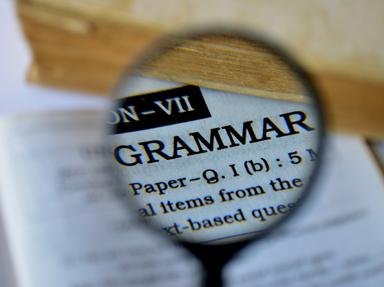Quiz Answer Key and Fun Facts
1. Lynne Truss writes that the title of her book, "Eats, Shoots and Leaves", came from a joke about a panda described as living up to the following entry in a wildlife handbook: "Panda. Large black-and-white bear-like animal native to China. Eats, shoots and leaves." How should this description be changed to eliminate the punctuation error?
2. Which of the following is an example of 'the greengrocer's apostrophe' (incorrectly using an apostrophe to form the plural of a word where only the letter 's' is needed)?
3. According to Lynne Truss in her book "Eats, Shoots and Leaves", which of the following is the correct way to refer to a collection of poems by Keats? (Some controversies do not have definitive answers!)
4. In her book "Eats, Shoots and Leaves", Lynne Truss describes a humorous theory which she calls 'The Law of Conservation of Apostrophes'. Which of the following sentences illustrates this law? (Hint: The Law of Conservation of Atoms (in a chemical reaction) states that atoms are neither gained nor lost in the process, they just get rearranged.)
5. In Lynne Truss's book "Eats, Shoots and Leaves" she refers to debate over the use of 'the Oxford comma'. Which of the following illustrates this use of the comma?
6. According to Lynne Truss in her book "Eats, Shoots and Leaves", which of the following sentences correctly uses a comma to join two thoughts?
7. In her book "Eats, Shoots and Leaves", Lynne Truss refers to two punctuation marks as 'the thermals that benignly waft our sentences to new altitudes'. On what marks, which help us to construct complicated yet intelligible sentences with multiple clauses, does she bestow this accolade?
8. According to Lynne Truss in her book "Eats, Shoots and Leaves", which of the following is a correct use for a colon?
9. In her book "Eats, Shoots and Leaves", which of the following does Lynne Truss NOT say is true of the exclamation mark? (Hint: Why do you use one? How often do you use one?)
10. In her book "Eats, Shoots and Leaves", which of the following does Lynne Truss NOT say is a reason for objecting to emoticons? (Hint: She is comfortable with the evolution of punctuation conventions over time, as she traces for more traditional punctuation marks in the book.)
Source: Author
looney_tunes
This quiz was reviewed by FunTrivia editor
agony before going online.
Any errors found in FunTrivia content are routinely corrected through our feedback system.

